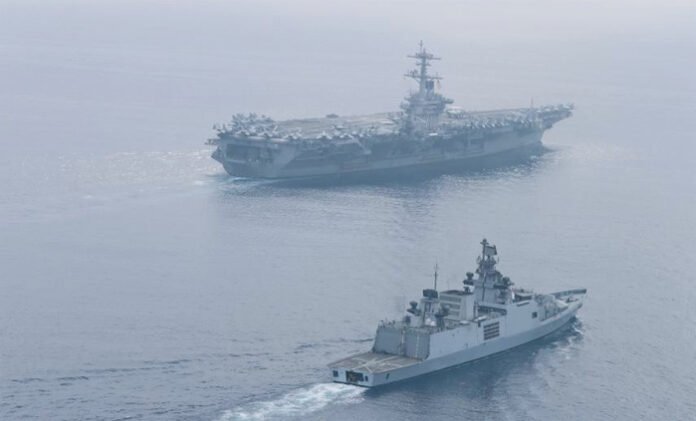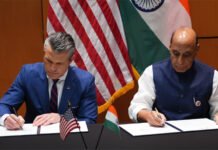India’s Eyes on the Ocean
In a strong assertion of maritime readiness, the Indian Navy has revealed that it is closely monitoring every Chinese vessel entering the Indian Ocean Region (IOR).
Senior naval officials confirmed that India maintains round-the-clock surveillance using a combination of satellite data, long-range maritime patrol aircraft, and advanced coastal radar systems.
“Every movement of a Chinese warship, research vessel, or submarine is tracked the moment it enters the Indian Ocean,” said Vice Admiral Sanjay Vatsayan, Vice Chief of Naval Staff, during a defense briefing in New Delhi. “We know who they are, where they are, and what they’re doing.”
🛰️ How India Keeps Watch: A 360° Maritime Surveillance Network
The Navy’s robust maritime awareness stems from its Information Management and Analysis Centre (IMAC) in Gurugram — the nerve center of India’s maritime intelligence.
Through IMAC, India monitors vessel activity from the Persian Gulf to the Strait of Malacca, a stretch of over 7 million square kilometers. The system integrates feeds from:
P-8I Poseidon aircraft equipped with anti-submarine warfare (ASW) sensors.
GSAT-7 and GSAT-7R naval satellites for encrypted communication.
Coastal radar chains in collaboration with island territories like Andaman & Nicobar and Lakshadweep.
White Shipping Agreements with 36 countries, providing real-time data on commercial shipping.
This layered network ensures that even Chinese “research” ships — often suspected of dual-use surveillance — are under constant observation.
“Our surveillance is proactive, not reactive,” an Indian Navy officer said anonymously. “We don’t wait for intelligence alerts; we anticipate them.”
🚢 Chinese Presence in the Indian Ocean: A Growing Concern
China’s maritime activities in the IOR have increased significantly over the past decade, coinciding with its ambitious Belt and Road Initiative (BRI) and string of pearls strategy — a network of ports and bases across the Indian Ocean littoral states.
In recent months, the Navy has tracked multiple Chinese People’s Liberation Army Navy (PLAN) vessels near Sri Lanka, Maldives, and the Bay of Bengal. Particularly, a so-called “research vessel,” the Xiang Yang Hong 03, sparked diplomatic concern when it docked in Colombo last month.
“China’s dual-use vessels collect data useful for submarine operations — that’s what makes them a strategic risk,” noted Commodore Uday Bhaskar (Retd.), defense analyst.
🇮🇳 India’s Counter-Strategy: Strength Through Partnerships
India is bolstering its maritime security not only through surveillance but also strategic partnerships across the Indo-Pacific.
Key initiatives include:
QUAD Cooperation with the U.S., Japan, and Australia for joint naval exercises.
Logistics Exchange Agreements allowing access to partner naval bases worldwide.
Mission SAGAR (Security and Growth for All in the Region) — India’s outreach to assist and stabilize smaller Indian Ocean nations.
India’s Andaman & Nicobar Command, the country’s only tri-service theater command, has also been modernized with upgraded runways, air defense systems, and expanded radar coverage.
“The Andaman Command gives India an unmatched vantage point over the Malacca Strait — a chokepoint crucial to Chinese energy supplies,” said Lt. Gen. S.K. Chaturvedi (Retd.).
🛡️ Securing the Blue Frontier
The Indian Navy’s focus now extends beyond traditional defense — encompassing energy security, trade route protection, and humanitarian operations.
With 90% of India’s trade by volume and 80% of its oil imports passing through sea lanes, securing maritime boundaries is an existential necessity.
“A secure ocean means a secure India,” Vice Admiral Vatsayan reiterated. “Our vigilance ensures peace through preparedness.”
The Navy also conducts joint patrols with countries like Indonesia, France, and Seychelles, strengthening its network of “trusted maritime partners.”
🌍 Global Strategic Context
India’s vigilant stance mirrors rising global concern over China’s expanding naval footprint — from the Djibouti military base in Africa to its influence in Gwadar (Pakistan) and Hambantota (Sri Lanka).
Western defense experts view India as a stabilizing power in the Indo-Pacific, capable of balancing China’s assertiveness through democratic alliances.
“The Indian Navy’s maritime domain awareness is now on par with advanced Western navies,” said James Stavridis, former NATO Supreme Commander. “It’s a quiet but powerful deterrent.”
















